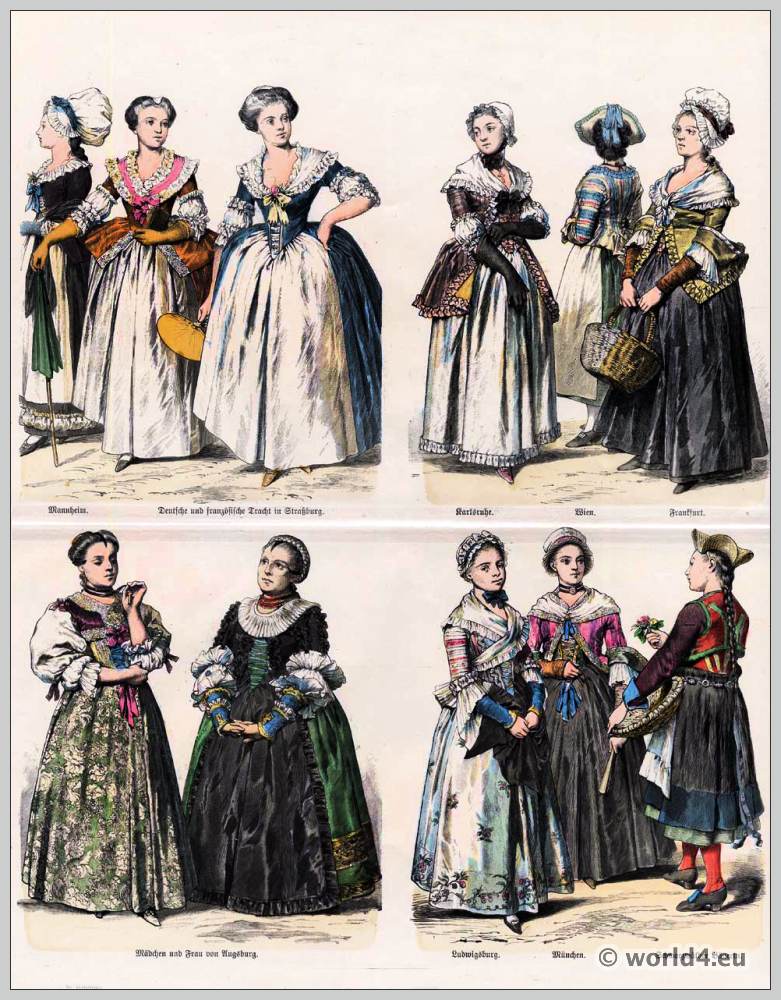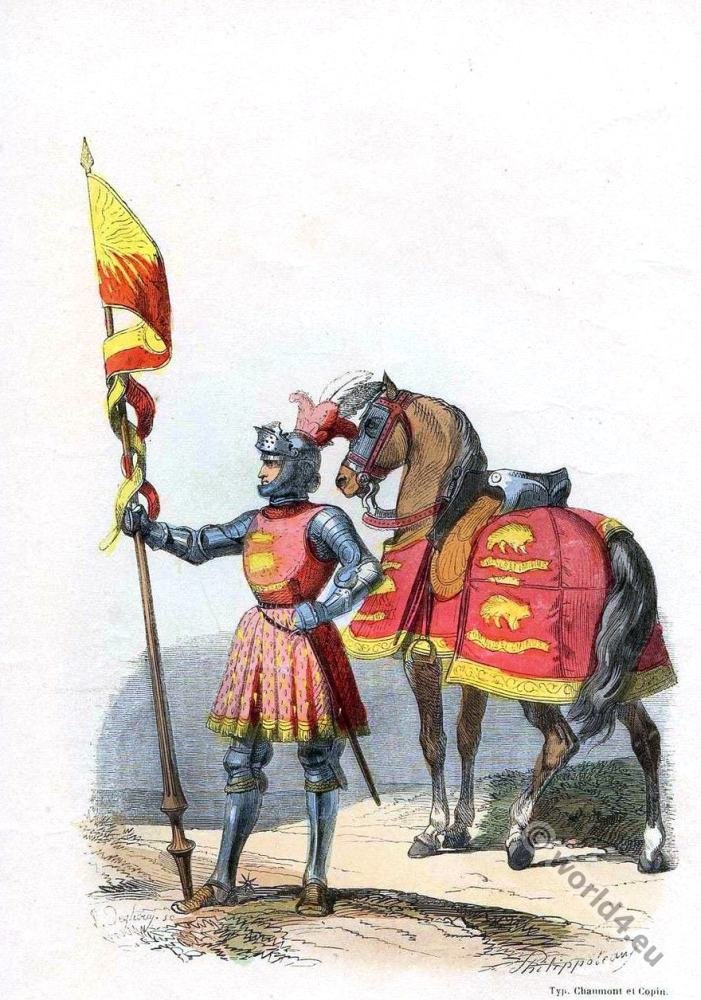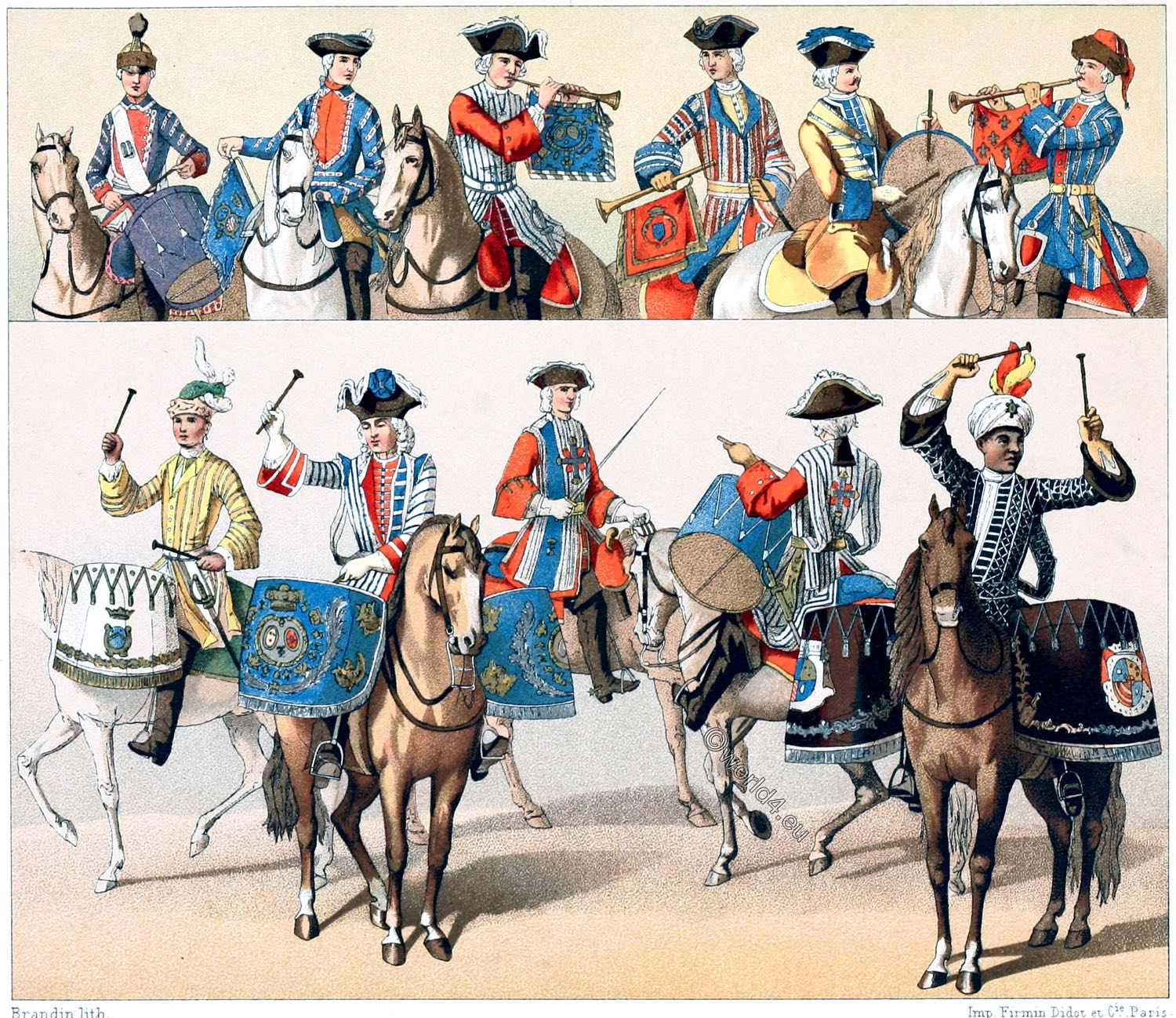
1, 2, 3, 4,
5, 6, 7, 8, 9,
FRANCE. XVIIITH CENTURY. UNIFORM. FIRST HALF OF THE CENTURY.
THE KING. HORSE RIDING OF THE ROYAL HOUSE. GARDE DU CORPS. FOREIGN TROOPS. HUSSARS AND ULANS.
No. 1. Officer of the Rattky Hussars 1724.
No. 2. Berchény Hussars, 1724.
No. 3. volunteer of the Marshal of Saxony, Ulan 1745.
No. 4. Cavalryman of the foreign troops of Clermont-Prince 1745.
No. 7. Louis XV, King of France, 1757.
No. 5. Gendarmes of the same period.
No. 6. King’s guardsman, Scottish company, same period.
No. 8. Gendarme of the guard of the same period.
No. 9. Chevau-legger of the Guard of the Corps of the same period.
The kings of France have always loved to surround themselves with a bodyguard. Philip August (Philip II of France 1165-1223) had already set up such a guard in Palestine, who did a good job at the Bouvines bridge in 1214 after his return. Charles VII united a Scottish corps with it, and until the end of the monarchy the Scots and Swiss formed the Garde du Corps, formed by Louis XI, as part of the Royal Housecorps.
The Gardes du dedans du Louvre consisted of four companies: the Gardes du Corps (the Scots and French), the Gardes Suisses, the Gardes de la porte and the Compagnie der Prévôté de l’hôtel.
The Gardes du dehors du Louvre consisted of cavalry from the gendarme and chevaulier companies, infantry from two regiments of the French and Swiss Guards. There were also two companies of musketeers on horseback and the hundred nobles, “au bec de corbin”.
Since Louis XIV the uniform of the regiments of the royal house was blue or red. White joined since Louis XV.
No. 5. – Gendarme. There were 16 gendarme companies, including 6 Chevauxlegger companies, formed by Louis XIV. The king was captain of the first four, the others were companies of princes and carried the ciphers of their bosses on their saddlecloths. Red skirt with silver trimming, isabelline waistcoat with black and white buttonholes, silver haloed bandelier in different colours. Sword, musket and two pistols.
No. 6. – Guardsman of the Scottish Companies. Blue skirt with red lapels, vest and trousers. Blue coat with red lining. All with silver galoning and braid. Blue bandelier and saddlecloth. Rapier, musket and two pistols.
No. 8. – Gendarme of the King’s Guard. Formed by Henry IV in 1590. Red skirt, rose and saddlecloth, with gold braid and same gala. Black lapels. Isabelline waistcoat. On the gold plumed hat a black cockade. A sword and two pistols. Their standards and pennants were made of white silk with a golden border; their motto was a lightning bolt with the words: Où Jupiter furieux ordonne; Where the angry Jupiter commands. The king was captain of the company, which numbered 210 men in 1757.
No. 9. – Chevauleger of the King’s Guard. Also formed by Henry IV in 1594. Scarlet skirt, black velvet cuffs, gallooned with golden braids; buttons and buttonholes in silver; red trousers; gold braided hat; white feather and cockade. Scarlet gold galloon saddlecloth. Sword and two pistols. The king was captain of this company. Their motto a lightning bolt smashing the giants, with the words: Sensere gigantes.
The army had kept about the same organisation since the last half of Louis XIV’s reign. Until 1757 the tight-fitting skirt with long laps and wide lapels was retained, for the cavalry the high tricorn, the long boots and the coat. The only changes are in the length or brevity of the waistcoat, in the adoption of the cleavage belt instead of the bandelier, the cartouche hanging from right to left and the boots with stiff shafts. The cockade in the form of a bow knot was preserved until 1775, when it was replaced by a pleated rosette.
The golden or silver epaulette was introduced as a degree badge in 1762. The monotony of the uniforms was only interrupted by the foreign corps, which kept their national costumes.
Nos. 1 and 3. – Rattky and Bercheny-Husars. Already in the XVII century there were Croats and Polish in the French army; but only in 1692 they appeared as royal hussars, formed from Hungarian deserters by the Marshal of Luxembourg. In 1707 the Elector of Bavaria gave the king a second regiment as a gift. After the Peace of Utrecht in 1713, united with the first one, it was under a Lord of Rattky. Bercheny (Ladislas Ignace de Bercheny, Marshal of France. He is widely known as the Father of French Hussars) proposed to recruit new hussars for the Rattky Regiment among the exiled Hungarians in Constantinople.
These foreign regiments (Étrangère de ligne) consisted only of an escadron (from the French word for squadron) and carried blue, pointed standards with the golden crown and lilies. Their weapons were the crooked sabre or a broad sword, pistols, a carbine; large cartridge pouches on the bandelier and sabre pouch completed their equipment. Their clothing was a short jacket with very tight sleeves and wide trousers, which were tucked into the ankle boots reaching down to below the knee. The pointed cap was trimmed with fur. They usually wore their heads shaved except for a small mop of hair on the right side. The officers wore themselves richer and distinguished themselves by a silver capsule on the chest.
The hussar uniform was not Frenchified until the second half of the XVIIIth century. In 1760 it was sky blue, later green with red trousers. In 1760 a corps hunter was joined on foot with the Berchény and Turpin hussars *).
*) On 21 December 1734, King Louis XV decided that a third Hussar Regiment should be established in addition to the two already permanent regiments de Rattsky (1716) and de Bercheny (1720). The regiment was to be stationed in Versailles. The unit was set up in Strasbourg and was named “Régiment de Esterhazy-Houzards” after the regimental commander, the Comte Valentin-Joseph Esterhazy. Renamed as “Régiment de Turpin Houzards” in January 1747.
No. 2 – Ulan from the volunteers of the Marshal of Saxony.
The ulans were volunteer noblemen, Vlachs and Poles. The regiment counted 1000 men, half of them were lancers, half pacolets *) or dragoons. The lancers in Tartar costume carried the lance, the broad sabre and two pistols. Both wore a kind of helmet trimmed with sealskin. The pacolets were armed with the sabre, two pistols and a shotgun with bayonet. It was not until 1745 that the traditional dress of the ulans, which was common in the 19th century, was adopted.
The pacolets of the regiment dug up by the Marshal of Saxony were actually, like the Polish Pascholeks, the servants of the actual ulans. Even in the French formation they remained a subordinate force to the latter. When the Marshal of Saxony had retired to Chambord, the King left him his regiment, which was on daily guard duty. After the Marshal’s death, the ulans returned to Poland, the pacolets or dragoons remained in French service as a regiment of foreigners (volunteers of Saxony, Volontaires de Saxe). In 1750 they were named after their chief and organized as Schomberg volunteers (Volontaires de Schomberg). At that time, the French army had a large number of volunteer corps.
The Clermont-Prince regiment consisted of cavalry and infantry and took the name Legion de Conde in 1766. These volunteer corps, known as light troops, ranked after the infantry, without actually belonging to it.
*) From the Polish pacholę (“boy”), which took on the meaning of a military servant, a hussar, or an armed man. The decree of 30 March 1743 allowed the formation of a regiment consisting of 6 brigades of 64 horsemen each. The horsemen were lancers (Uhlands), each followed by a “pacolet”, i.e. a servant.
Nos. 5, 6, 7, 8 u. 9 from the Nouveau Recueil des troupes, qui forment la garde et maison du Roi, published by the widow Chéreau in 1757.
Nos. 1 and 3 from the Collection de Costumes et scènes militaires, published by Guérart, 1692, 1712.
Nos. 2 and 4 from the Annuaires militaires and after simultaneous engravings in the great work by Noirmont and Alfred de Marbot.
Cf. French military costumes of de Noirmont and de Marbot. The State of France, 1702. – The Art of War by Marschall of Puységur, 1749.
Source: History of the costume in chronological development by Auguste Racinet. Published by Adolf Rosenberg. Berlin 1888.
Related
Discover more from World4 Costume Culture History
Subscribe to get the latest posts sent to your email.






